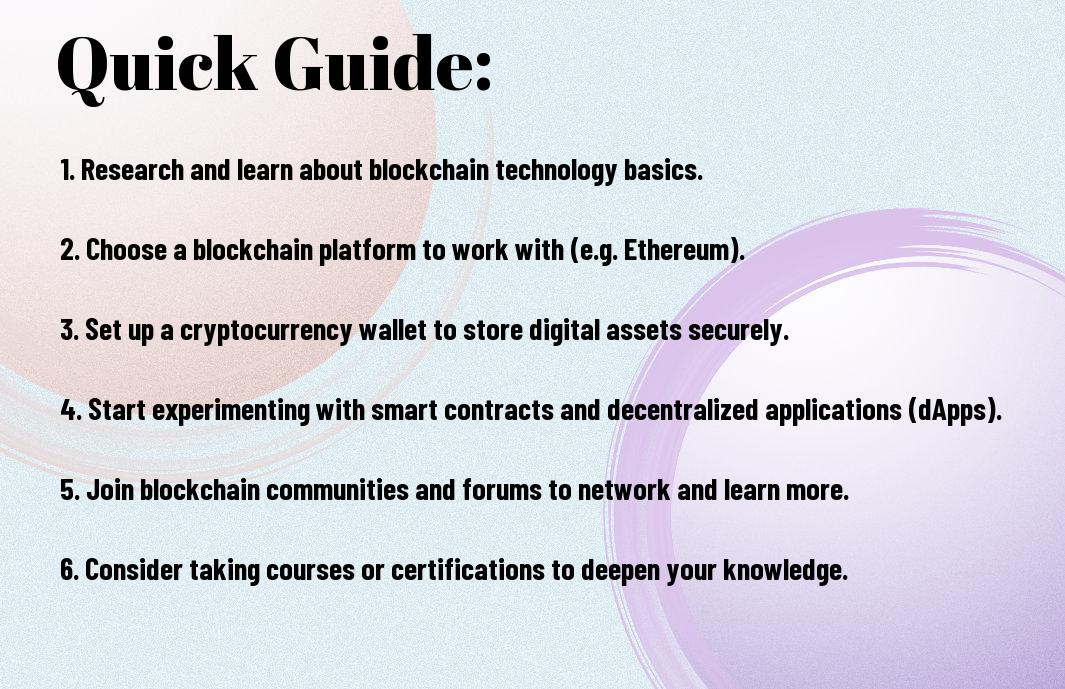Blockchain technology is revolutionizing various industries by offering secure, transparent, and decentralized solutions. If you’re intrigued by the potential of Blockchain but unsure where to begin, this guide is here to help you take the first steps towards understanding and working with this groundbreaking technology. Whether you are interested in developing applications, investing in cryptocurrencies, or simply expanding your tech knowledge, delving into Blockchain can open up a world of opportunities. For those looking to dive deeper into Blockchain development, check out this Amazing Tech Jobs: How to Become a Blockchain Developer resource.

Understanding Blockchain Basics
While blockchain technology is gaining popularity across various industries, it’s necessary to have a solid grasp of the basics before diving in. Understanding the fundamentals of blockchain is crucial for grasping its potential applications and benefits.
Types of Blockchain Technology
- Public Blockchain: A decentralized network where anyone can participate and view the blockchain’s data.
- Private Blockchain: Operated by one organization, allowing for controlled access to the blockchain.
- Consortium Blockchain: Shared among a group of organizations, providing a balance between public and private blockchains.
- Permissioned Blockchain: Users must have permission to join the network, ensuring data security.
- Hybrid Blockchain: Combines elements of both public and private blockchains for enhanced flexibility.
The various types of blockchain technology cater to different needs and preferences, offering diverse solutions for businesses and individuals. The classification of blockchains helps in determining which type would best suit a particular use case. The choice of blockchain type significantly impacts factors like accessibility, transparency, and security.
How Blockchains Work: A Step-by-Step Overview
To comprehend how blockchains function, it’s crucial to break down the process into smaller, understandable steps. Below is a simplified overview of how blockchains operate:
| Step 1 | Explanation |
| 1. Data Entry | New data is entered into a block. |
| 2. Block Formation | The data gets verified and added to a block. |
| 3. Linking Blocks | The new block is linked to the previous block, creating a chain. |
| 4. Consensus | Validators agree on the validity of the new block. |
| 5. Block Addition | The validated block becomes part of the blockchain. |
You can grasp the functioning of blockchains better by understanding the step-by-step process involved in adding new data to the chain. This breakdown simplifies a complex technology into clear, manageable steps, showcasing the transparency and security embedded within blockchain systems.
How Blockchains Work: A Step-by-Step Overview
You can rest assured that your transactions are secure due to the decentralized nature of the blockchain. Every transaction is verified and added to a block in a sequential order, making it tamper-proof. Another key aspect is the consensus mechanism, where network participants agree on the validity of transactions, ensuring trust and transparency. Additionally, the immutability of data on the blockchain ensures that once recorded, information cannot be altered or deleted, enhancing data integrity.
Preparing to Dive into Blockchain
Factors to Consider Before Getting Started
Unlike traditional technologies, Blockchain is a unique and complex ecosystem that requires careful consideration before diving in. Before you start your journey, there are a few key factors to keep in mind:
- Technical Knowledge: Understanding the basics of Blockchain technology and how it works is crucial.
- Security Concerns: The decentralized nature of Blockchain requires a focus on security measures to protect your assets.
- Regulatory Compliance: Stay informed about the legal implications of using Blockchain technology in different regions.
Any misstep in these areas could lead to challenges along the way, so it’s important to have a solid understanding of these factors before getting started.
Setting Up for Success: Tips and Resources
Started your journey into Blockchain technology can be overwhelming, but with the right approach, you can set yourself up for success. Here are some tips and resources to help you along the way:
- Education: Enroll in online courses or attend workshops to deepen your knowledge.
- Community Involvement: Join Blockchain forums and engage with experts to gain insights and advice.
- Stay Updated: Keep yourself informed about the latest trends and developments in the Blockchain space.
Perceiving these tips and resources will not only help you navigate the complexities of Blockchain technology but also position you for success in your endeavors.
Taking the First Steps
Choosing the Right Blockchain for Your Needs
First, when getting started with blockchain technology, it’s necessary to choose the right blockchain that aligns with your project requirements. Whether you’re looking for a public or private blockchain, each has its unique features and use cases. Consider factors such as scalability, consensus mechanism, security, and community support before making a decision.
A Step-by-Step Guide to Your First Blockchain Project
Now, let’s look into a step-by-step guide to help you kickstart your first blockchain project. Breaking down the process into manageable tasks can make the journey less daunting and more achievable. Follow the table below for a structured approach:
| Step | Description |
| 1 | Define your project scope and objectives clearly. |
| 2 | Choose the right blockchain platform based on your requirements. |
| 3 | Develop and test your smart contracts or applications. |
| 4 | Deploy your project on the chosen blockchain and monitor its performance. |
This step-by-step guide will help you navigate through the complexities of blockchain technology and ensure a smoother project execution. Keep in mind, preparation is key to success in any blockchain endeavor.

Navigating the Blockchain Landscape
The Pros and Cons of Using Blockchain
Now, let’s explore the pros and cons of using blockchain technology. It’s important to weigh the benefits and drawbacks before incorporating it into your business.
| Pros | Cons |
| Increased transparency | Security vulnerabilities |
| Immutable record-keeping | Scalability issues |
| Decentralization | Regulatory uncertainty |
| Reduced transaction costs | Energy consumption concerns |
Future-Proofing: Staying Updated with Blockchain Trends
Little changes can have a big impact in the fast-evolving world of blockchain technology. Staying updated with the latest trends and developments is crucial to future-proof your business and ensure you are leveraging the full potential of this innovative technology.
With blockchain technology constantly evolving and new advancements being made, keeping an eye on emerging trends such as interoperability between different blockchains, the rise of decentralized finance (DeFi), and the increasing adoption of non-fungible tokens (NFTs) can give you a competitive edge in your industry.
To wrap up
Now that you have a better understanding of how to get started with blockchain technology, remember that the key is to start small and gradually expand your knowledge and skills. Begin by familiarizing yourself with the basics of blockchain, such as the concept of decentralized databases and smart contracts. Explore different blockchain platforms and tools to find the ones that best suit your needs. Don’t be afraid to experiment and learn from your mistakes, as blockchain technology is constantly evolving. With dedication and perseverance, you’ll soon be on your way to becoming a blockchain expert!
FAQ
Q: What is Blockchain technology?
A: Blockchain technology is a decentralized, distributed ledger that records transactions across many computers in such a way that the registered transactions cannot be altered retroactively. It provides transparency, security, and efficiency in data management.
Q: How can I get started with Blockchain technology?
A: To get started with Blockchain technology, you can begin by learning the basics of how it works, understanding its potential use cases, and exploring different blockchain platforms and cryptocurrencies. Online courses, tutorials, and communities can also be valuable resources for gaining knowledge and practical experience.
Q: What are some popular applications of Blockchain technology?
A: Blockchain technology finds applications in various industries, including finance (cryptocurrencies, smart contracts), supply chain management, healthcare (patient data management), voting systems, and more. It has the potential to revolutionize the way data is stored and transmitted securely across different sectors.
